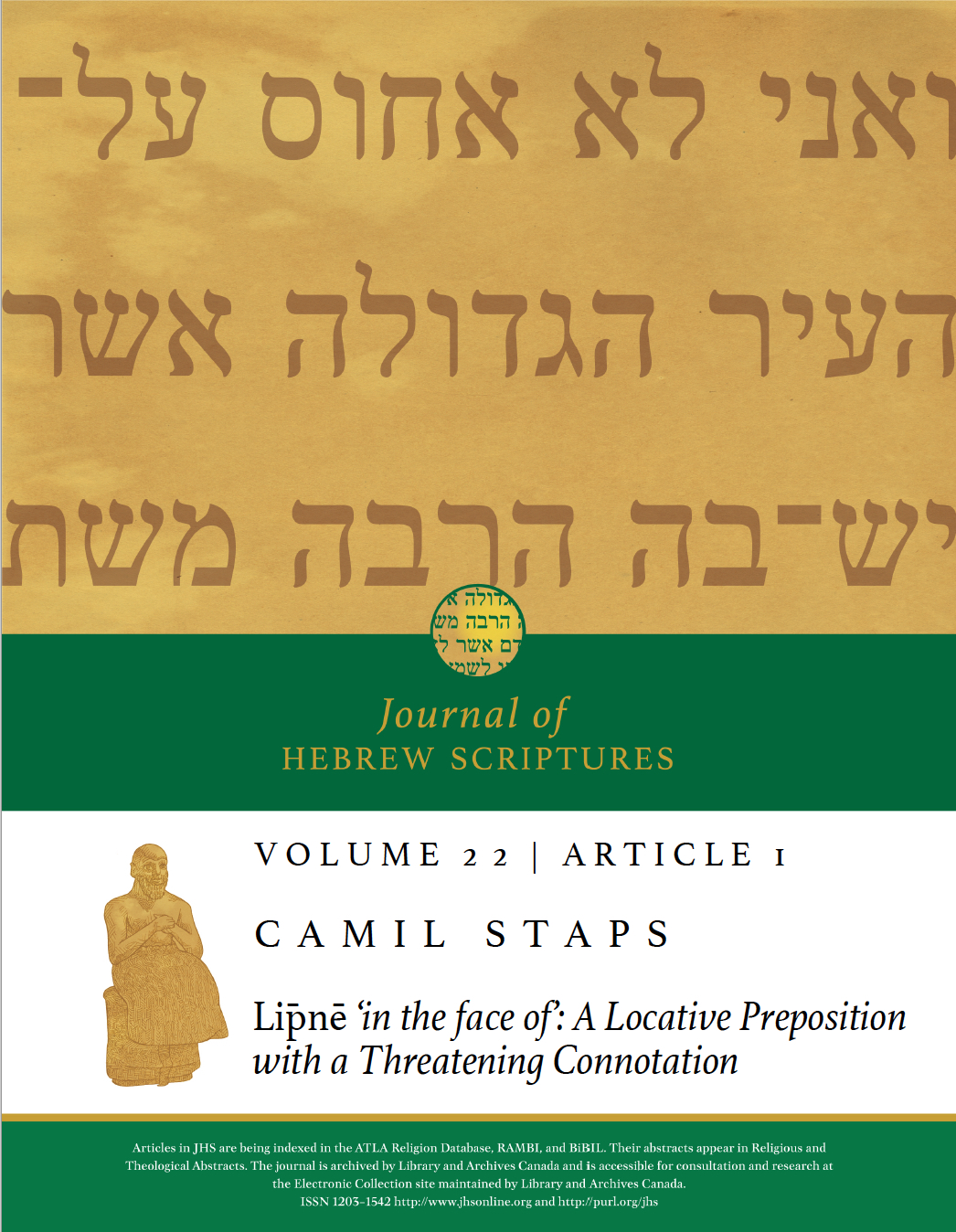Lip̄nē ‘in the face of’: A Locative Preposition with a Threatening Connotation
DOI:
https://doi.org/10.5508/jhs29582Abstract
The expression lip̄nē, literally "to the face of," is commonly translated as "before." In combination with the root ngp ("inflict/defeat"), this leads to awkward English translations; e.g., "Israel was defeated before the Philistines" (1 Sam 4:2). What exactly is the role of the Philistines in this event? In recent years, some scholars have used grammaticalization theory to argue that lip̄nē in this context is an Agent marker: "Israel was defeated by the Philistines." However, this view is untenable in the face of arguments from narratology, syntactic-semantic restrictions, grammaticalization theory, and language typology. In present-day English, the near-literal translation "in the face of" is a better alternative: lip̄nē is a simple Locative prepositional expression, but the element "face" has the connotation that Israel is threatened by the Philistines. In other words, Israel is in the "realm of influence" of the Philistines. The actual Agent of ngp is Yahweh, who determines the result of battles, as can be seen in the active voice: "Yahweh defeated Benjamin in the face of Israel" (Judg 20:35). In fact, the meaning of the Hebrew expression is cross-linguistically common; the only problem is that the meaning of the English preposition "before" has shifted, so that the original translation came to be misunderstood.
References
Al-Adaileh, Bilal A., and Renad Abbadi. 2012. “The pragmatic implications of metonymi-cal body-based idioms in Jordanian Arabic.” Argumentum 8:73–91.
Bicknell, Belinda Jean. 1984. “Passives in Biblical Hebrew.” PhD diss., University of Michigan.
Davis, Anthony R. 2011. “Thematic roles.” Pages 1:399–420 in Semantics. Edited by Claudia Maierborn, Klaus von Heusinger, and Paul Portner. Handbooks of Linguistics and Communication Science 33. Berlin: De Gruyter.
Dikke Van Dale (Den Boon, C. A., and R. Hendrickx), eds. 2015–2017. Dikke Van Dale Online. https://www.vandale.nl.
Foley, William A., and Robert D. Van Valin. 1984. Functional syntax and universal gram-mar. Cambridge: Cambridge University Press.
Gruber, Jeffrey. 1965. “Studies in lexical relations.” PhD diss., MIT. Bloomington: Indiana University Linguistics Club.
Hardy, Humphrey Hill II. 2014. “Diachronic Development in Biblical Hebrew Prepositions: A Case Study in Grammaticalization.” PhD diss., University of Chicago.
Harley, Heidi. 2011. “Thematic Roles.” Pages 861–862 in Cambridge Encyclopedia of the Language Sciences. Edited by Patrick Colm Hogan. Cambridge: Cambridge Univer-sity Press.
Hoffmann, Sebastian. 2005. Grammaticalization and English complex prepositions: a corpus-based study. Routledge advances in corpus linguistics 7. London and New York: Routledge.
Hopper, Paul J., and Elizabeth Closs Traugott. 2003. Grammaticalization. 2nd ed. Cam-bridge Textbooks in Linguistics. Cambridge: Cambridge University Press.
Huddleston, Rodney, and Geoffrey K. Pullum. 2002. The Cambridge Grammar of the English Language. Cambridge: Cambridge University Press.
Jackendoff, Ray. 1996. “The Architecture of the Linguistic-Spatial Interface.” Pages 1–30 in Language and Space. Edited by Paul Bloom, Mary A. Peterson, Lynn Nadel and Merrill F. Garrett. Cambridge, Massachusetts: The MIT Press.
Jones, Ethan C. 2018. “More than ‘Before’: Semantics and Syntax of לפני.” Pages 217–232 in The Unfolding of Your Words Gives Light: Studies on Biblical Hebrew in Honor of George L. Klein. Edited by Ethan C. Jones. University Park: Eisenbrauns.
Jones, Ethan C. 2020. “Middle and Passive Voice: Semantic Distinctions of the Niphal in Biblical Hebrew.” Zeitschrift für die alttestamentliche Wissenschaft 132/3:427–448.
Joüon, P., and T. Muraoka. 2006. A Grammar of Biblical Hebrew. 2nd ed. Rome: Gregori-an & Biblical Press.
Kraska-Szlenk, Iwona. 2014. “Semantic extensions of body part terms: common patterns and their interpretation.” Language Sciences 44:15–39.
Lakoff, George, and Mark Johnson. 1980. Metaphors we live by. Chicago: University of Chicago Press.
Littlemore, Jeanette. 2019. Metaphors in the Mind: Sources of Variation in Embodied Metaphor. Cambridge: Cambridge University Press.
OED. OED Online. 2021. Oxford University Press. https://www.oed.com.
Palancar, Enrique L. 2002. The Origin of Agent Markers. Studia Typologica 5. Berlin: Akademie Verlag.
Pullum, Geoffrey K. 2006. “Phrasal prepositions in a civil tone.” Pages 41–45 in Far from the madding gerund and other dispatches from Language Log. Edited by Mark Liberman and Geoffrey K. Pullum. Wilsonville, Oregon: William, James & Co.
Primus, Beatrice. 2016. “Participant roles.” Pages 403–418 in Routledge Handbook of Semantics. Edited by Nick Riemer. Abingdon: Routledge.
Ringgren, Helmer. 2001. “עָמַד ʿāmaḏ.” Pages 178–187 in vol. 11 of Theological Diction-ary of the Old Testament. Edited by Johannes G. Botterweck, Helmer Ringgren, and Heinz-Josef Fabry. Translated by David E. Green and Douglas W. Stott. 17 vols. Grand Rapids, Michigan: Eerdmans, 1977–2021.
Rodriguez, Daniel L. 2017. “אחר, מ/לפני, and תחת: An Embodied Cognitive Approach to the Biblical Hebrew Prepositions.” PhD diss., University of Stellenbosch.
Seppänen, Aimo, Rhonwen Bowen and Joe Trotta. 1994. “On the so-called complex prepositions.” Studia Anglica Posnaniensia 29:3–29.
Sollamo, Raija. 2003. “The Passive with an Agent in Biblical Hebrew and Its Rendering in the Septuagint.” Pages 617–629 in Hamlet on a Hill: Semitic and Greek Studies Pre-sented to Professor T. Muraoka on the Occasion of his Sixty-Fifth Birthday. Edited by M. F. J. Baasten and W. T. Van Peursen. Orientalia Lovaniensia Analecta 118. Leuven: Peeters.
Strecker, Ivo. 1993. “Cultural variations in the concept of ‘face’.” Multilingua 12/2:119–141.
Testen, David. 1998. “The Derivational Role of the Semitic N-stem.” Zeitschrift für Assyri-ologie 88:127–145.
Tyler, Andrea, and Vyvyan Evans. 2003. The Semantics of English Prepositions: Spatial Scenes, Embodied Meaning and Cognition. Cambridge: Cambridge University Press.
Ukosakul, Margaret. 2005. “The significance of ‘face’ and politeness in social interaction as revealed through Thai ‘face’ idioms.” Pages 117–125 in Broadening the Horizon of Linguistic Politeness. Edited by Robin T. Lakoff and Sachiko Ide. Pragmatics & Be-yond New Series 139. Amsterdam: John Benjamins Publishing Company.
Van Wolde, Ellen. 2009. Reframing Biblical Studies. When Language and Text Meet Cul-ture, Cognition, and Context. Winona Lake, Indiana: Eisenbrauns.
Van Wolde, Ellen. 2019. “The Niphal as Middle Voice and its Consequence for Meaning.” Journal for the Study of the Old Testament 43/3:453–478.
Van Wolde, Ellen. 2021. “Nifʿal Verbs in the Book of Genesis and Their Contribution to Meaning.” Pages 431–453 in New Perspectives in Biblical and Rabbinic Hebrew. Edited by Aa-ron D. Hornkohl and Geoffrey Kahn. Cambridge Semitic Languages and Cultures 7. Cambridge: Cambridge University Press & Open Book Publishers.
Waltke, Bruce K., and M. O’Connor. 1990. An Introduction to Biblical Hebrew Syntax. Winona Lake, Indiana: Eisenbrauns.
Walzer, Michael. 1992. “The Idea of Holy War in Ancient Israel.” The Journal of Religious Ethics 20/2:215–228.
Yu, Ning. 2001. “What does our face mean to us?” Pragmatics & Cognition 9/1:1–36.

Downloads
Published
How to Cite
Issue
Section
License
Copyright (c) 2022 Camil Staps

This work is licensed under a Creative Commons Attribution 4.0 International License.

 Statue of Ebih-Il, drawing by Simeon Goa, © Journal of Hebrew Scriptures
Statue of Ebih-Il, drawing by Simeon Goa, © Journal of Hebrew Scriptures
